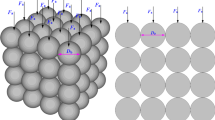Abstract
This paper presents the use of infinite element boundary conditions for physical and engineering problems in a three-dimensional unbounded domain, subjected to seismic loading, with a view to compare results with the traditional viscous boundary. Boundary conditions are discussed in general with an emphasis on understanding the pros and cons of each method used. Also, a comparison is drawn between the different types of boundary conditions used for the optimal solution of physical problems especially the models under seismic loading. Infinite elements can be implemented easily with lesser computational time. It provides “quite” boundaries to the models and can be used effectively for the accurate numerical solutions of physical issues. This paper presents the complete details of node setting and numerical computation for the infinite element boundaries and compares results of a three-dimensional free field soil model and a soil–tunnel model under seismic loading using infinite boundary, and a similar model using a spring/dashpot system. The results verified the use infinite element boundary to evaluate the seismic behaviour of the model and suggest that in the time domain, this method can be combined easily with the finite element and other methods such as boundary element method directly.

















Similar content being viewed by others
References
J S Gui et al. Appl. Mech. Mater.353–356 (2013)
H Y Zhang et al Sci. Technol. Min. Metall.23 685 (2016)
C R Dowding Int. J. Rock Mech. Min. Sci. Geomech. Abstr.15 83 (1978)
P Pineda et al Adv. Mater. Res.133 (2010)
C K Seal et al Int. J. Mod. Phys. B24 2478 (2010)
S L Kramer Geotechnical Earthquake Engineering (New Jersey: Prentice Hall) (1996)
Ž Nikolić et al Earthq. Eng. Struct. Dyn.46 159 (2017)
L Jing and J A Hudson Int. J. Rock Mech. Min. Sci.39 409 (2002)
Z H Wang et al Appl. Mech. Mater.166 636–640 (2012)
P Li, EX Song Int. J. Numer. Anal. Methods Geomech.40 344 (2016)
J P Wolf Earthq. Eng. Struct. Dyn.26 931 (1997)
P Li and E X Song Soil Dyn. Earthq. Eng.48 48 (2013)
M Saleh Asheghabadi and M A Rahgozar Iran. J. Sci. Technol. Trans. Civ. Eng. 1–15 (2018). https://doi.org/10.1007/s40996-018-0214-0
B Engquist and A Majda Math. Comput.31 629 (1977)
Lysmer and R L Kuhlemeyer J. Eng. Mech. Div. ASCE95 859 (1969)
M Saleh Asheghabadi and H Matinmanesh Proc. Eng.14 3162 (2011)
H Matin Manesh and M Saleh Asheghabadi The Twelfth East Asia-Pacific Conference on Structural Engineering and Construction (2011)
L Zdravkovic and S Kontoe The 12th International Conference of International Association for Computer Methods and Advances in Geomechanics (IACMAG) (2008)
L Kellezi Soil Dyn. Earthq. Eng.19 533547 (2000)
Kontoe S PhD thesis (Imperial College, University of London) (2006)
J Bielak, K Loukakis, H Yoshiaki and C Yoshimura Bull. Seismol. Soc. Am.93 817 (2003)
L-Y Fu and R-S Wu Geophysics65 596 (2000)
L-Y Fu and Y G Mu Acta Geophys. Sin.37 521 (1994)
L-Y Fu 66th Ann. Internat. Mtg. Soc. Expl. GeophysI 1239 (1996). https://doi.org/10.1190/1.1826323
L-Y Fu, Y G Mu and H J Yang Geophysics62 650 (1997)
J Wang 18th International Conference on Structural Mechanics in Reactor Technology (SMiRT 18) Beijing (2005)
D Givoli, J B Keller Comput. Methods Appl. Mech. Eng.76 41 (1989)
P Bettess Int. J. Numer. Method Eng.11 54–64 (1978)
O C Zienkiewicz, K Bando, P Bettess, C Emson, T C Chiam Int. J. Numer. Method Eng.21 1229 (1985)
I Kaljevis, S Saigal, A Ashraf Int. J. Numer. Method Eng.35 2079 (1992)
H N Andreas Eng. Comput. Mech.167 3–12 (2013)
Y Kagawa, T Yamabuchi and S Kitagami Boundary Element Methods in Engineering (Berlin: Springer) 1017 (1983)
I Kaljević I et al Int. J. Numer. Method Eng.35 2079 (1992)
ABAQUS User Manual, Viewed on 15 Jan 2019. http://abaqus.software.polimi.it/v6.13/books/usb/default.htm?startat=pt06ch28s03alm03.html
G Goch and M Reigl J. Appl. Phys.79 9084 (1996)
M Saleh Asheghabadi, M Sahafnia, A Bahadori, N Bakhshayeshi Int. J. Environ. Sci. Technol.16(7) 2961–2972 (2019)
Author information
Authors and Affiliations
Contributions
Mohsen Saleh Asheghabadi coordinated and supervised the progress of the research. He performed the numerical analysis using ABAQUS and presented the results and analysis. Zulfiqar Ali worked on the literature review and infinite element boundary formulations and prepared the manuscript.
Corresponding author
Additional information
Publisher's Note
Springer Nature remains neutral with regard to jurisdictional claims in published maps and institutional affiliations.
Rights and permissions
About this article
Cite this article
Saleh Asheghabadi, M., Ali, Z. Infinite element boundary conditions for dynamic models under seismic loading. Indian J Phys 94, 907–917 (2020). https://doi.org/10.1007/s12648-019-01533-4
Received:
Accepted:
Published:
Issue Date:
DOI: https://doi.org/10.1007/s12648-019-01533-4




